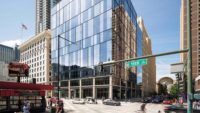“Sustainability without equity is sustaining inequity.” That’s how Mandy Lee, program manager of the NAACP’s Centering Equity in the Sustainable Building Sector (CESBS) Initiative, sums up the green building movement’s long-standing tendency to shortchange social factors. “Like many other environmental efforts, green buildings are not reaching Black and brown communities,” she says.
This is especially problematic as the climate crisis heats up, and the disproportionate burdens on already disadvantaged communities start to compound. “We’re on both sides of that double-edged sword,” says Jacqueline Patterson, senior director of the NAACP’s Environmental and Climate Justice Program. “Our communities are the sacrifice zone for fossil-fuel-based energy generation, and we are disproportionately impacted by the results of climate change.”
Whether it’s air pollution, urban heat islands, wildfire risk, flooding, or substandard buildings in earthquake and hurricane zones, communities of color are more likely to find themselves in harm’s way. Of the 2 million Americans living within three miles of the 12 dirtiest coal-power plants, 76 percent are people of color. In 108 urban areas across the country, 94 percent of formerly redlined neighborhoods are hotter than nearby non-redlined areas, by as much as 7 degrees. (Redlining was the historical practice of refusing mortgages or insurance to whole neighborhoods based on racially motivated considerations, which in some areas continues de facto, if illegal, discrimination.) Census tracts that are majority Black, Hispanic, or Native American experience about 50 percent greater vulnerability to wildfire compared to other census tracts. The list goes on.
Just to mitigate these threats is not enough. The real goal in designing for communities on the front lines of climate change, says Patterson, is to shift the benchmark from merely surviving to thriving, embracing culture, and fostering the ability to pursue a fulfilling life.
To see what that could look like, RECORD checked in with architects working on solutions at four scales. At the building scale, Leddy Maytum Stacy Architects’ recently completed Edwin M. Lee Apartments in San Francisco; at the community scale, Mithun’s collaboration with the residents of North Richmond, California, as part of the Resilient By Design Bay Area Challenge; at the urban and watershed scales, an advocacy-through-design effort led by Rice University’s Present/Future program; and at the scale of the architecture profession itself, the University of Oregon’s Design for Social Justice Initiative.
Leddy Maytum Stacy Architects (LMSA) has long operated at the intersection of sustainable design and social equity, and the recently opened Edwin M. Lee Apartments (with associate architects Saida + Sullivan Design Partners) exemplifies this work. “While climate-change-related challenges are universal, they disproportionately affect low-income and homeless people, who have fewer resources and options to address them,” says LMSA partner Richard Stacy, echoing Patterson’s comments. A variety of socioeconomic factors—such as poverty, race, and physical or mental challenges—can generate overlapping circles of inequity. “Our focus was on making this the most equitable and the most sustainable project it can be,” says Stacy.

To optimize passive-energy performance while offering a place for respite, LMSA organized the housing around a south-facing garden. Photo © Bruce Damonte, click to enlarge.
Developed by the nonprofits Chinatown Community Development Center and Swords to Plowshares, and named in honor of the late San Francisco mayor for his affordable-housing advocacy, the 124,000-square-foot building in the Mission Bay neighborhood provides 62 apartments for formerly homeless veterans and 57 apartments for families earning less than 60 percent of area median income (AMI), or about $69,000 for a family of three. Integrating strategies to improve resilience, reduce resource consumption, and improve residents’ quality of life has put the project on track to achieve Platinum certification from GreenPoint Rated—a California-based standard for residential construction. It allocates points in categories that encompass energy and water efficiency, indoor air quality, and community. While social justice isn’t a stated goal, the program includes credits for such equity-enhancing measures as universal design and affordability. Identifying synergies between the twin priorities of sustainability and social justice was key to achieving the project’s goals on an affordable housing budget, says Stacy.

Community areas in LMSA’s housing project have direct access to this shared outdoor space. Photo © Bruce Damonte
The five-story building is organized around a south-facing landscaped courtyard, which optimizes passive-energy performance and daylighting while offering areas for contemplation, gardening, and play. The first floor is elevated, a tactic that anticipates sea-level rise (with a hinged slab at each building threshold to maintain an accessible entrance even as the sidewalk—built on fill on a former marsh—continues to subside). In the meantime, the raised floor improves the privacy of first-level units.
The building is ventilated with filtered 100 percent outdoor air, which supports residents’ health day to day, as well as when wildfire smoke makes it hazardous to open a window.
A sawtooth facade provides each unit with more than one outlook and admits daylight from multiple directions. Its rainscreen cladding of colorful cementitious panels improves the building’s thermal and weather performance and durability. And its building-integrated photovoltaic panels generate more than 90 percent of the electricity needed to power the project’s common areas. In addition to its technical performance, says Stacy, “the dramatic and contemporary exterior helps bring pride of place to affordable housing.”
Pride of place emerged as a priority at the community level in Mithun’s collaboration with North Richmond, California, as part of the 2018 Resilient By Design (RBD) Bay Area Challenge. The Challenge connected design professionals and area communities to catalyze ideas and collaborations and work toward a comprehensive regional plan. The location of the unincorporated district (population, about 5,000) between two flood-prone creeks, an oil refinery, and a major arterial highway that separates the neighborhood from the shore—combined with structural race-based injustices and economic barriers—have impeded residents’ efforts to improve their quality of life. So, although the RBD Challenge originated as a quest for ways to manage the region’s growing flood risks, “we couldn’t think about resilience and climate response without first thinking about the deep disparities of wealth in the Bay Area,” says Hilary Noll, sustainability integration leader at Mithun.

The ouR-HOME design incorporates a horizontal levee to protect the community from rising tides while also serving as an accessible, migrating edge to a habitat-rich marsh. Image courtesy Mithun
The year-long design project, known as ouR-HOME (with the R referring to both “Richmond” and “Resilient”), generated a suite of community-driven concepts for North Richmond that prioritize strategies for neighborhood stabilization and homeownership, as well as for living with rising water. Examples of the former include a community land trust to acquire vacant lots, and a zoning overlay to allow small-lot splits (subdivisions of existing urban sites to facilitate more compact and affordable developments). Examples of strategies for living with water include an innovative horizontal levee to protect the community and low-lying infrastructure from rising tides while also serving as an accessible, migrating edge to a habitat-rich marsh.

ouR-HOME scheme proposes a highway overpass connects the community to the waterfront. Image courtesy Mithun
To ensure ouR-HOME’s design expressed community priorities, Mithun’s approach was grounded in deep listening, says Noll, “rather than the design team parachuting in as white saviors.” The Home Team (as the collaboration called itself), included an advisory board of community-nominated participants from diverse perspectives such as local nonprofits, water-infrastructure management, and estuary conservation. These representatives were paid a stipend for their time. Mithun also retained the Oakland-based Institute for Sustainable Economic Educational and Environmental Design (ISEEED) to facilitate meetings, so that people of color were speaking to people of color while the designers listened. “One of the big take-aways,” says Debra Guenther, a partner at Mithun, “is that, as designers, we’re designing a process as much as a tangible thing.”
With previous outsider-led initiatives, says Princess Robinson, a member of the Home Team’s advisory board and a project manager with local nonprofit Urban Tilth, “what we’ve seen in most cases is that anything new being built has no relationship to the residents that actually live here.” But this time was different. “The team just came in so open,” Robinson says. “It created a space where we’re all working together, and those relationships are on-going.” In addition to the design solutions themselves, the strengthened social infrastructure (which includes connections to city and county planners) is responsible for continuing progress two years later.
A newly formed nonprofit is now shepherding the housing concepts forward, and the zoning overlay for small-lot splits has been well received by the county planning department in preliminary discussions. The levee is garnering broad support from a diverse range of interested parties. And a creek-trail activation program is continuing until resources become available to build an overpass that will connect the trail to the waterfront.
Where ouR-HOME is developing strategies for adapting in place, graduate studios in Rice University School of Architecture’s Present/Future program, Houston, are developing proposals for responding to that city’s persistent flooding with managed retreat (the purposeful and coordinated movement of people and buildings away from risk).

To tackle chronic flooding in low-lying areas of Houston, a program at Rice University has outlined a phased managed-retreat strategy that would enhance resilience and be largely self-financing. Image courtesy Albert Pope, Present Future
In 2017, Hurricane Harvey put a third of Houston under water, wreaking $125 billion worth of damage. A year later, of houses that had been badly damaged, 27 percent of Hispanic- and 20 percent of Black-owned homes remained unsafe, compared to 11 percent of white-owned homes. “Climate change is a force multiplier,” says Albert Pope, director of the Present/Future program. It intensifies existing problems so that “the people who get hurt the most are those who are the most disadvantaged in the first place.”
Surveys of residents of Westbury, a low-income, flood-prone Hispanic and Black neighborhood in Houston’s Brays Bayou watershed, found that many wanted to move, but their insurance would only cover renovations—it wouldn’t buy them out. Although the Harris County Flood Control District has been buying vulnerable properties on an ad hoc basis for the past 35 years, so far it has accounted for only 3,500 of the approximately 100,000 buildings in the bayou system’s 100-year floodplain. Not only is this pace ineffective, “there’s no plan for the buyout,” Pope says, “which means you’re not paying attention to how you’re transforming the city.”
Taking up the slack, Pope and the graduate students in his studios, in partnership with the Rice Design Alliance, the university’s Department of Anthropology, and community leaders, have developed proposals to demonstrate that addressing climate risk, social and environmental inequity, and urban reform together can achieve a greater return on investment than large engineering projects that simply move water around.
The concept is this: buy out untenable upstream properties and convert them to flood-retention infrastructure. And design the infrastructure as public green space, connecting to a network of trails, so that when the land is dry (which is nearly all of the time), it’s an amenity. Use additional buyouts fronting on the green space to replace and increase housing by building back more densely, with respect for the water, thereby also improving energy and transportation metrics and overall livability. Critical to the social equity of the scheme are measures to ensure that former residents of the bought-out properties have the opportunity, and can afford, to move into the new housing.
Strategic phasing of the scheme would allow it to be largely self-financing, especially if the costs of averted downstream flooding are taken into account. “This is an opportunity to make these areas safe,” says Pope, “and, at the same time, to make the city better.”
While these proposals have succeeded in stimulating discussion, and district officials increasingly see the need for a comprehensive approach to floodplain reclamation, inertia behind the status quo is enormous. That’s why Pope and his students are developing alternatives proactively. “As designers, we need to be ready for a sea change in the economics and politics of managed retreat,” he says. “The point of our proposals is to show that design is indispensable to any solution.”
For the most part, however, equity-fostering and climate-facing projects like the ones profiled here are still far too uncommon. “One of the things we’re trying to articulate with the CESBS Initiative is that the AEC sector is not really active in environmental justice right now,” says the NAACP’s Lee.
As advocates and practitioners begin working to change that, architecture schools are also taking steps. For example, the University of Oregon (UO), which was an early adopter of environmentalism in architectural education, has now implemented an innovative program to incorporate social justice.
Supported philanthropically by a group of Portland- and Seattle-based architecture firms, UO School of Architecture and Environment’s Design for Spatial Justice Initiative (DSJI) recruits cohorts of visiting faculty to integrate under-represented perspectives into the architecture curriculum. The initiative also flips students’ assumptions about social vulnerability by acknowledging community representatives as instructors, rather than beneficiaries, of studio work.
At first glance, the DSJI might look like a diversity initiative to change the demographics of the faculty, or a pedagogical initiative to change what’s being taught—both of which are true, says Erin Moore, director of UO’s School of Architecture and Environment. But beyond that, “it’s significant to see a person from an underrepresented group who is affected by these disproportionate impacts teaching the topics from lived experience.”
Ultimately, says the NAACP’s Lee, “we’re trying to completely reorient the green building movement so that sustainability is defined as having racial justice and economic justice—in addition to environmental stewardship—at the center.” She’s summing up the goal of the CESBS Initiative, but she could be describing the DSJI, the Rice floodplain reclamation plan, ouR-HOME, or the Ed Lee Apartments: it is an aspiration that all of these projects share.
Continuing Education

To earn one AIA learning unit (LU), including one hour of health, safety, and welfare (HSW) credit, read “Environmental Inequity,” and:
Then complete the quiz. Upon passing the test, you will receive a certificate of completion, and your credit will be automatically reported to the AIA. Additional information regarding credit-reporting and continuing-education requirements can be found at continuingeducation.bnpmedia.com.
Learning Objectives
- Discuss why climate change disproportionately affects the health and well-being of disadvantaged communities.
- Describe some initiatives to tackle these inequities in the built environment and the architecture profession.
- Describe methods for creating designs that reflect a community’s priorities and support its well-being.
- Discuss how green building standards address social justice issues.
AIA/CES Course #K2010A





Post a comment to this article
Report Abusive Comment